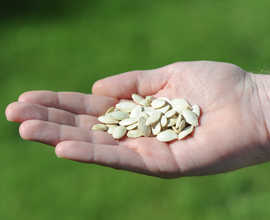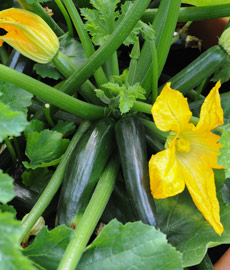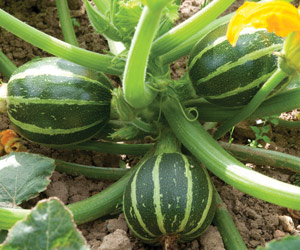
How to grow courgettes
Courgettes are easy to grow vegetable plants that crop prolifically through summer and into early autumn. They differ from larger marrows in that they are ready for picking very soon after flowering, though they will swell and form marrows if left to develop.
How to grow courgettes
There are several types of courgette, plants can be compact and bushy, trailing or climbing, and fruits can be green, striped or yellow. Fresh, young, seedless fruits have a firm texture and good flavour compared to watery and seedy marrows. Courgette flowers are a delicacy too, and can be stuffed or fried or given the tempura batter treatment. Yellow courgette varieties are proving popular among chefs and foodies as they hold less water, making them more suitable to a wide range of uses in the kitchen. Read our guide below and find out how to grow courgette plants in the garden or in pots at home.
When to grow courgettes
Courgette plants are frost tender. As such, they should be treated as a seasonal summer crop. Sowing should be timed so plants are ready to go outside after the last frost of spring. Sow too late and you risk not getting a crop before the first frosts of autumn. In the ground or in pots, make sure to choose an open sunny position for the best results.
How to sow courgettes
Indoors:

Courgettes seeds are relatively large and flat making them easy to work with. For the earliest crops, seeds should be sown in April under glass, but most growers tend to sow in the greenhouse or on windowsill in May. Sow courgette seeds 1cm (1/2") deep in 7.5cm (3") pots filled with a free draining seed- or multipurpose compost.
Set the seeds on their edge - if laid flat, water can sit on top of the seed and cause it to rot off before germinating. Place pots in a propagator or seal your pots inside a clear polythene bag and keep at 20-25C (68-77F) until after germination, which usually takes 7-10 days. Do not exclude light as this helps germination. As soon as growth is seen, remove propagator lids and bag covers.
Top Tip: Yoghurt pots with pierced drainage holes in the bottom make excellent sowing pots for courgettes.
Outside:
For later crops, or when indoor sowing is not possible, direct sow seeds during the first half of June, in prepared soil where the plants are to grow. Germination outside can me more erratic so it is best to set three seeds per station and thin to the strongest seedling once they are underway.
If you miss the opportunity to sow seed, use courgette plug plants as an alternative. We offer courgette seeds year-round and we offer courgette plants for sale in season.
Where to sow courgettes
Courgette plants can be grown in traditional rows on the veg patch, spacing 90cm (36") apart, or dotted around the patch to fill gaps. They perform best in free draining soils. Add plenty of organic matter, such as well rotted manure or homemade compost, when preparing the planting site.
How to grow courgettes in containers
Courgettes grow very well in containers. Choose pots of around 10litres in size (a builder's bucket with holes drilled in the bottom would be ideal). Fill pots with a quality multipurpose compost, high in organic matter. For the best results when growing courgettes in pots, plant in incredicompost®, mixing in incredicrop® prior to planting up.
How to care for your courgettes

Plant out early sown plants under cloches or frames in late spring, or wait until after the last hard frost and plant without protection. Acclimatise plants to outside conditions for 10 to 14 days before planting out (setting outside by day and bringing back under cover each evening). Keep plants well watered to prevent soils or container compost from drying out. Use a one off long-season fertiliser such as incredicrop® at planting time, or apply a weekly liquid tomato feed to plants once they start to flower. Courgette flowers are insect pollinated. In a cold season when there might be a lack of natural pollinators, or if fruits are just failing to develop, setting can be improved with hand pollination. Pick a male flower (one with no immature fruit behind the flower), pull away the petals and insert the stamen into each female flower to transfer the pollen. Train trailing and climbing courgettes up frames as a great space saver.
When to harvest courgettes
Plants sown early in April could be ready to harvest from as early as June depending on weather and growing conditions, but late July and August provide the best picking opportunities. Aim to harvest several times a week through the season to prevent developing fruits from growing too large. Courgette fruits are at their best when they are around 10cm (4"). Left to grow longer they will lose texture and flavour, and fruiting potential will be greatly reduced. Wear long sleeves when harvesting courgettes as some varieties have spiky hairs on their stems which can cause irritation while working with the plants. Use a sharp clean blade to cut the fruits from the plants.
Common courgette problems
Powdery Mildew: A common problem that hits the majority of courgette plants before the end of the season, seen as a white powdery coating on foliage. It is caused by dry soil and humidity around the plants. Keep courgette plants well spaced to increase airflow around them. courgette powdery mildewKeep evenly watered to prevent dry soils, and avoid wetting foliage. Add a mulch layer on soil around plants to retain moisture.
Slugs and snails: These can be a problem on young plants. Use copper bands/ tape or your choice of slug pellet to keep them under control. As plants mature, slugs and snails become less of a problem, but they can attack fruits.
Cucumber mosaic virus: Growth looks stunted and/or deformed with leaves taking on a yellow mosaic patterning. Flowering is greatly reduced, and fruit already growing will remain small and turn dark green with yellow patches. There is no chemical control. Infected plants should be removed and destroyed. The virus is transferred by sap sucking insects so prevent these from getting onto your plants. Do not handle healthy plants after dealing with infected specimens. Courgette Defender F1 shows good resistance to this problem.
Aphids and whitefly: These can transfer viruses between plants and/or excrete sticky honeydew onto foliage which can lead to sooty moulds developing. A variety of chemical and organic sprays are available to control infestations. Monitor pest activity with yellow sticky traps above plant foliage.
Foot and root rots: Darkening of stem bases and root deterioration, leading to wilted top growth. This is caused by overwatering on poorly drained soil. There is no control for these once they set in. Plants are best replaced after improving soil conditions.
Top 10 courgette varieties

- Courgette 'Defender' F1 Hybrid
- Courgette 'All Green Bush'
- Courgette 'Black Forest' F1 Hybrid
- Courgette 'British Summertime' F1 Hybrid
- Courgette 'Sure Thing'
- Courgette 'Parador' F1 Hybrid
- Courgette 'Zephyr' F1 Hybrid
- Courgette 'Midnight' F1 Hybrid
- Courgette 'Eclipse' F1 Hybrid
- Courgette 'Shooting Star' F1 Hybrid
For more inspiration on growing courgettes with kids and how to use up a glut, check out our courgette hub page for everything you need to know about growing this tasty summer squash.

Written by: Kris Collins
Kris Collins works as Thompson & Morgan's communications officer, making sure customers new and old are kept up to date on the latest plant developments and company news via a wide range of media sources. He trained in London's Royal Parks and has spent more than a decade writing for UK gardening publications before joining the team at Thompson & Morgan.Sign Up For Exclusive Special Offers




© 2024 Thompson & Morgan. All rights reserved. A division of Branded Garden Products Limited.



